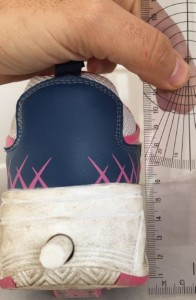A UMH study alerts about the use of roller shoes by children
Campus, Fuente, Investigación, Investigaciones, Noticia, Front UMH, Sant Joan d'Alacant
28 April 2016
Research by Roberto Pascual, Assistant Professor of Podiatry at the Miguel Hernández University of Elche (UMH), alerts about long-term use of roller shoes in school environments, because they can cause podiatric problems in users due to the weight of these shoes, the heel height, and lack of flexibility, in addition to the very roller and its instability.
The most critical element of these shoes is their heel height. The difference between some shoe models with and without a roller can be as much as 5 cm. Scientific studies show that when we stand barefoot, 75% of our body weight is borne by the heel while the forefoot bears the remaining 25%. As we increase the heel height, the forefoot bears a greater load, and this can have consequences of growth problems, Freiberg’s disease, or metatarsalgia, in addition to possible long term-shortening of the posterior muscle chain and its relationship with talalgia, such as Sever’s disease, and interfere in the natural evolution of pediatric flat foot. A comparison between a barefoot child with one wearing roller shoes and another in roller shoes with the roller deployed shows that the forefoot load increases by 20% while wearing this footwear with respect to the barefoot child, and by up to 40% while wearing this footwear with the roller deployed versus the barefoot child. Forefoot overload in roller shoes is comparable to constant use of heels that are between 4 and 5 cm high.
This load transfer from the heel to the forefoot alters proprioception, information that the body receives from nerve endings in the sole of the foot. This causes heel bones to grow less, resulting in a narrow heel, which, over the long term, can lead to negative consequences for the child. Wearing this type of footwear also alters the parameters of pressure on the heel. Likewise, the heel height can, over the long term, reduce posterior musculature because a child who uses roller shoes walks abnormally. The reduction of these muscles (calves, soleus and ischiotibial) is related as much in the development of flatfoot as in the influence of its non-physiological development, the main problem in child podiatry, in addition to back problems. Furthermore, roller shoes weigh twice as much as normal athletic footwear, thus requiring a greater expenditure of energy.
For more than 10 years, the UMH has been carrying out a primary care program of podiatric health at nursery and primary schools in the Valencian Community thanks to an agreement with the Ministry of Education of the Generalitat Valenciana. Every year, a group coordinated by UMH Assistant Professor Roberto Pascual, along with fourth-year podiatry students, conducts checkups on some 600 children between 3 and 12 years of age. These checkups take place at schools in municipalities that include El Campello, Mutxamel, and Sant Joan d’Alacant.
In this podiatric health program at schools, Roberto Pascual has observed that more than one-half of the students present data that is compatible with normal function, while for more than one-third of them, podiatric checkups were recommended. Data that was not compatible with normal function was present in 9.1% of them, related mainly with scoliosis, while 0.5% showed skin lesions. As for the children who were referred to a podiatrist, most were due to flatfoot data that were not compatible with normal function: 40% were due to the prevalence of pediatric flatfoot, 40% due to gait alterations, while the remaining 20% presented digital alterations and possible lower limb asymmetry.
The footwear examinations show that 83% of children wear appropriate footwear in terms of the size of their feet. However, there is a high incidence of children who attend school wearing footwear that is specific to some athletic activity. As such, 62% of them attend school in footwear that is specific to playing futsal or football. As for the use of roller shoes, it was observed that 11% of the students attended school wearing this type of shoe on the day of the checkup.
Further information is available at: http://www.cgcop.es/index.php/noticias/35-un-estudio-alerta-sobre-el-uso-de-deportivas-con-ruedines
